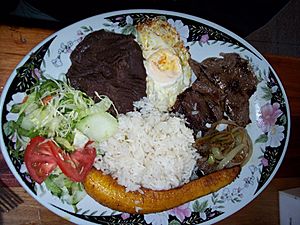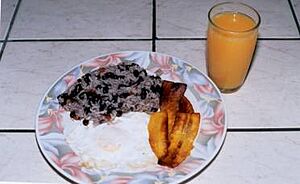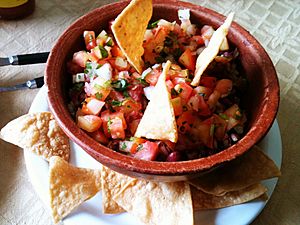Costa Rican cuisine facts for kids

Costa Rican food is known for being quite mild. It uses lots of fresh fruits and vegetables. Rice and black beans are a big part of most traditional meals. People often eat them three times a day! Costa Rican food is usually very healthy. It is almost always cooked from scratch using fresh ingredients. Because Costa Rica is in a tropical area, tropical fruits and vegetables are easy to find and used a lot in cooking.
Costa Rica has many tourists, but also many small, quiet communities. This means you can find many different kinds of food, especially in cities. Places like San José, the capital, and popular beach towns offer foods from all over the world. You can find Peruvian food or Japanese food. Chinese and Italian food are very popular with Ticos. Ticos is what people call Costa Ricans. Food is a very important part of Costa Rican culture. Family get-togethers and parties often happen around a meal.
The first people of Costa Rica, like the Chorotega, ate a lot of maize (corn) before Europeans arrived. Even though Spanish culture changed Costa Rican food a lot, corn is still important in many dishes. Tamales are a special food that came from the Aztecs in Central America. They are eaten at almost all celebrations in Costa Rica, especially at Christmas. Tamales are made from cornmeal dough, fat, and spices. They are filled with different meats, rice, and vegetables. Then they are wrapped in a plantain or banana leaf and steamed. The Chorotega people used to fill their tamales with deer or turkey meat. They also added pumpkin seeds, tomatoes, and sweet peppers.
The Caribbean coast of Costa Rica has its own special foods. These foods are influenced by Afro-Caribbean traditions. During holidays, you might find crispy fried pork or a soup called mondongo. A common dish on the Caribbean side is rice and beans cooked in coconut milk. This is different from gallo pinto. This dish is usually served with fish and some type of fried plantain.
Contents
Main Ingredients in Costa Rican Food
Rice and beans are in almost every Costa Rican meal. They are especially common for breakfast. Potatoes are another important food in Costa Rica. They are part of the starchy diet that Ticos enjoy.
Pork and beef are the most common meats eaten. But chicken and fish dishes are also easy to find. Fish is especially popular on the Caribbean coast.
The plantain is a larger fruit from the banana family. It is used a lot and can be cooked in many ways. Ripe plantains (called maduro) are sweet. They can be fried, baked with honey or sugar sauce, or added to soups. Green (unripe) plantains can be boiled in soups. They can also be sliced, fried, smashed, and fried again to make patacones. Patacones are often served with a bean dip or guacamole.
Salsa Lizano was created in 1920 by a Costa Rican company. Over the years, it has become a very common condiment and cooking ingredient. You can find it in homes and restaurants all over the country. It has a tangy taste. It is made with water, sugar, salt, onions, carrots, cauliflower, cucumber, pepper, mustard, turmeric, and monosodium glutamate. Salsa Lizano is used in many Costa Rican dishes, like gallo pinto and tamales. Some people compare it to Worcestershire sauce.
Popular Traditional Dishes
Gallo pinto is the national dish of Costa Rica. Its name means "spotted rooster" because of how it looks. It is made by stir-frying rice and beans together in a pan. This gives it a speckled look. It is usually eaten for breakfast with scrambled or fried eggs, and sour cream or cheese. The rice and beans are seasoned with cilantro, red pepper, onion, celery, and Salsa Lizano. Gallo pinto is also the national dish of Nicaragua, a country next to Costa Rica. People in both countries often debate about the best way to make it. Pinto, as locals call it, is available everywhere and is very affordable.
For lunch, the traditional meal is called a casado. Casado means "married man" in Spanish. It got this name because wives used to pack this lunch for their husbands when they went to work in the fields. It has rice and beans served side by side, not mixed. There is usually some type of meat like beef, fish, pork chop, or chicken. A salad is also usually included. Sometimes there are extras like fried plantain (patacones or maduro), a slice of white cheese, or corn tortillas.
When families gather or for special events, it is common to make arroz con pollo. This dish is rice with chicken mixed with vegetables, mild spices, and of course, Salsa Lizano.
Bocas, or boquitas, are like Costa Rican appetizers. They are small snacks or tiny portions of main dishes. You can find them in most bars, taverns, and at big parties. Patacones are a common boquita. Another popular one is gallos, which are small Tico-style tacos. They have beef, chicken, or arracache (a starchy vegetable) inside a warm corn tortilla.
Ceviche is a dish made from raw fish and seafood. It can include octopus, shrimp, shellfish, tilapia, dorado, mahi-mahi, and sea bass. The raw seafood is soaked in lemon juice. The lemon juice "cooks" the seafood by changing its proteins. Then it is mixed with seasonings like coriander, onion, garlic, cilantro, and chillis.
Chicharrón is fried, crispy pork. It is popular in bars and with local people. Chifrijo is a dish that became popular in the 1990s. Its name comes from combining "chicharrón" and "frijoles" (beans). It is served with rice and pico de gallo, which is a fresh salsa. This snack often comes with tortilla chips.
Olla de carne, meaning "pot of beef", is a stew. It came from Spanish influences after Costa Rica became independent. It has beef, cassava (a starchy root vegetable), potatoes, maize (corn), green plantains, squash or chayote, and other vegetables.
Small snack stands or stores, called sodas, often sell corn turnovers called empanadas. These are filled with ground beef, chicken, cheese, or a fruit mix. Another popular snack or side dish is yuca frita, or fried yuca (cassava). It is similar to fried potatoes but has a sweeter taste.
Chorreadas are corn pancakes. They are not as common as some other traditional dishes. They are usually served for breakfast with sour cream.
Drinks in Costa Rica
Coffee is one of Costa Rica's biggest exports. You can find it in almost every restaurant and home. It is served black or with milk (called café con leche). It is usually strong and very good quality.
Agua dulce is a common Tico drink. It is made from tapa de dulce (raw cane sugar, also called panela) dissolved in hot water. This drink is especially popular in the cooler highlands and mountains.
Frescos and batidos are drinks made from fresh fruit and milk or water. Some fruits used include papaya, mango, watermelon, cantaloupe, pineapple, strawberry, blackberry, banana, carrot, tamarind, guanábana, and cas. Cas is a sour fruit found only in Central America. Horchata, a drink made from cornmeal and cinnamon that started in Spain, can be found in the northwestern Guanacaste Province. A special holiday drink is homemade ginger beer. It is found on the Caribbean side and sometimes mixed with wine.
Refrescos is the local name for bottled soft drinks. They are sold everywhere. Most common brands are available. In rural areas, sellers sometimes sell soft drinks in plastic bags, which are cheaper than cans or bottles.
Agua de pipa is simply a green coconut with a straw to drink the water inside. Sellers, called piperos, often walk around tourist areas selling green coconuts. When you buy one, the seller chops off the top with a machete and puts in a straw.
A common phrase in Costa Rican restaurants is agua con gas. This means "water with gas," or carbonated water. Water is generally safe to drink in Costa Rica, but it is not always guaranteed.
Sweet Treats and Desserts
Most Costa Rican desserts are made with milk, corn, sugarcane, eggs, or fruit. In the Limón province, many desserts use a coconut base or fried plantains. In the Guanacaste Province, the main dessert ingredient is usually corn. In the Puntarenas Province, it is mostly milk, coconut, and fruit.
One of the most common desserts is tres leches. This means "three milks" in English. It is a moist cake made mainly of milk and sugar. The ingredients include whole milk, evaporated skim milk, sweetened condensed milk, as well as heavy cream, eggs, sugar, ground cinnamon, baking powder, vanilla extract, and dark rum. You can find it in many restaurants. People usually eat it after lunch or dinner.
Fruit salad is another popular dessert in Costa Rica. Some fruits typically used are fresh watermelon, mango, papaya, pineapple, and banana.
A special Christmas cake dessert is queque navideño, or Christmas cake. It is similar to fruitcake and is made with dried fruit. It is a sweet and heavy dessert. It is usually soaked in rum for a few days before it is baked. Costa Ricans enjoy giving this Christmas cake to friends and families as gifts.
See also
 In Spanish: Gastronomía de Costa Rica para niños
In Spanish: Gastronomía de Costa Rica para niños



